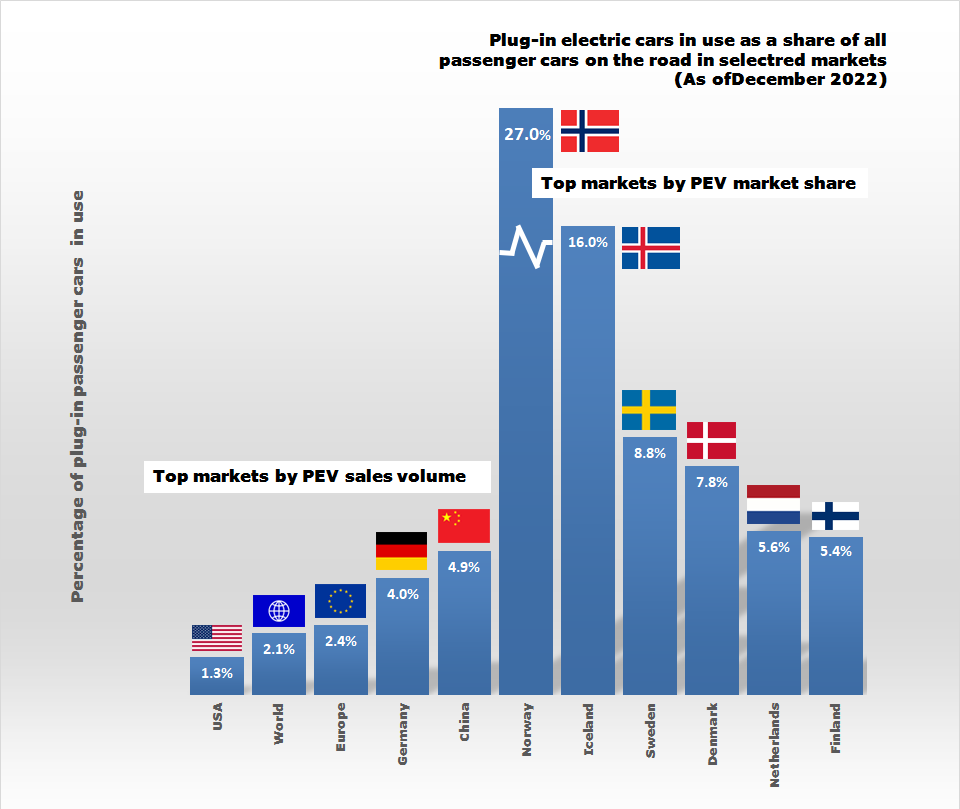
Henry Ford and Thomas Edison were both working, in 1912, on a new invention: the automobile. Edison’s was electric. Ford’s was powered by gasoline. What might the world look like today, if Edison’s design had prevailed?

Norway might offer a preview. The Nordic country will stop selling gas-powered cars in two years. In 2022, over 80% of new cars sold were electric. Carbon emissions have declined by 30 percent in Oslo, Norway’s capital. The air is cleaner, the city is quieter. Government subsidized charging stations line the roads. The grid has not buckled; those formerly employed in fossil-fuel jobs have been able to transition. The only problem, so far, is an increase in tiny particles of pollution entering the air as a result of the friction of fast EVs and asphalt highways. When the United States Federal Highway System anticipates the increase in electric vehicles, perhaps the surface of roads, often renewed in the summer season, can be adjusted.

Ironically, it was Henry Ford’s legacy that turned Norway towards electric vehicles several decades ago. Ford Motor Company collaborated on, and later acquired in the late 1990s/early 2000s, a car called “Think City” that captured the imagination of Norwegian motorists, in no small part because of policies including no import tax and no highway tolls. (Ewing 2023)

Another irony: while Norway has pledged to reduce carbon dioxide emissions to a goal of zero (or close) by 2030, and electric vehicles are helping to reach that goal, Norway continues to drill for oil and gas. While Norway may be cleaner and greener, the country’s production of $180 billion worth of fossil fuels may see more exports. Russia-Ukraine conflict increased the need; Norway responded. Pipeline gas for Germany jumped 11%. Norway also sent gas to Belgium, France, Poland, and the UK. In 2028, Norway’s government plans to nationalize some Gassled pipelines. Norway’s network of gas pipelines rivals some countries’ highways: the pipes cover 5,600 miles (9,000 kilometers). By comparison, the Trans-Alaska Pipeline is 800 miles (1,287 kilometers) in length.

Meanwhile, 98% of Norway’s power generation comes from renewable energy, predominantly hydroelectricity. But transport has been a challenge. Norway introduced a National Transportation Plan (2018-2029) requiring all new ferries to use low emission technology, and all new cars and vans to be electric, all new city buses to be fueled by biogas. (Sweco 2023) With a focus on the transport sector, ports will also be designed as energy centers where ships may power up with a mix of biogas, hydrogen, and electricity. Because transport accounts for 60% of Norway’s carbon emissions, and the Nordic nation has set a plan for zero (or low) emissions, the world may get a preview of the track to mobilizing the future.

Buli, Nora. “Norway piped gas exports rise 3.3% in 2022, set record for Germany” 23 January 2023. Reuters. https://www.reuters.com/business/energy/norway-piped-gas-exports-rise-33-2022-fall-just-shy-record-2023-01-23/
Ewing, Jack. ‘In Norway, the Electric Vehicle Future Has Already Arrived” 10 May 2023. The New York Times. https://www.nytimes.com/2023/05/08/business/energy-environment/norway-electric-vehicles.html?smid=nytcore-ios-share&referringSource=articleShare
Litwin, George H., John J. Bray, K. Lusk Brooke. Mobilizing the Organization: Bringing Strategy to Life. London: Prentice Hall, 1996. ISBN: 0131488910
Sweco. “Report: Race to Electrification – Norway in a Pole Position.” https://www.swecogroup.com/urban-insight/energy/report-race-to-electrification-norway-in-a-pole-position/
Building the World Blog by Kathleen Lusk Brooke and Zoe G. Quinn is licensed under a Creative Commons Attribution-NonCommercial-NoDerivs 3.0 U
